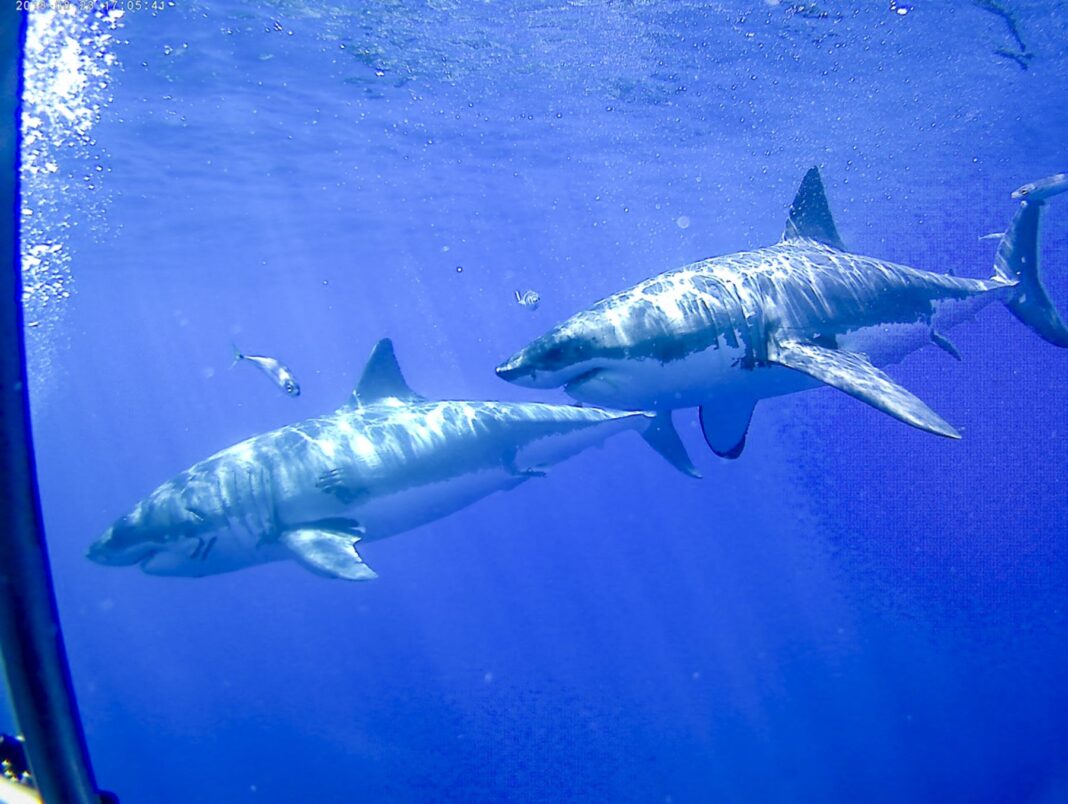Great white sharks around Mexico’s Guadalupe Island sometimes hang out with each other – and while it’s not a popularity contest, some might just be a little more social than others, writes Angela Nicoletti of Florida International University (FIU).
FIU marine scientist Yannis Papastamatiou, PhD candidate Sarah Luongo, and a team of researchers, wanted to uncover some of the mysteries of the white sharks that gather seasonally around Guadalupe Island. With an innovative combination of tracking tools, they found sharks tend to stick together when patrolling, like stopping by to check out the seal colonies around the island. Some were together for more than an hour.
“Most associations were short, but there were sharks where we found considerably longer associations, much more likely to be social associations,” said Papastamatiou, lead author of the study. “Seventy minutes is a long time to be swimming around with another white shark.”
Guadalupe Island is brimming with tuna and seals, making it a hotspot for white sharks. Unlike other places white sharks spend time, such as South Africa and Australia – where waters are murkier, and the sharks launch sneak attacks on prey – Guadalupe Island’s waters are blue and very clear. Prey is easily seen, but prey can also see the predators. The research team wanted to see if the sharks were adjusting their hunting strategies and doing something differently.
Normally, studying such cryptic animals involves some form of tracking device. To study thes sharks, the researchers decided they would need a bigger, better tag.
So, they combined different commercially available technology into a “super social tag” that collected data for up to five days before popping off the shark’s dorsal fin and floating to the surface. It was equipped with a video camera and an array of sensors tracking acceleration, depth, direction, and how rapidly the shark turned while swimming. What put the “social” in this specific tag was special receivers that could detect other tagged sharks nearby.
Those other tagged sharks were the result of previous work the study’s co-author and chief scientist at Fins Attached Marine Research and Conservation Mauricio Hoyos-Padilla had done over the years to track the movements of white sharks around Guadalupe Island. Around 30 to 37 of those sharks showed up on the white sharks’ super social tags.
The team tagged six white sharks – three males and three females – over a four-year period. Data shows, for the most part, that they prefer to be in groups with members from their same sex. It also showed that individual sharks behave uniquely.
One shark that kept its tag on for only 30 hours had among the highest number of associations – 12 sharks. Another had the tag on for five days and only spent time with two other sharks.
They also displayed different hunting tactics. Some were active in shallow waters, others in the depths. Some were more active during the day, others at night.
The challenge of the hunt was reflected in the video footage, analyzed by FIU undergraduate Seiko Hosoki. A great white followed a turtle. Then, the turtle saw it and got away. A great white followed a sea lion. Then, the sea lion spotted it, danced loops around the shark and got away.
As Papastamatiou points out, predators are unsuccessful a lot of the time when hunting. That’s why forming social associations might be important.
Papastamatiou has studied the social lives of other shark species and noticed a link between sociality and the ability to take advantage of another shark’s hunting success. The same thing may be happening at Guadalupe Island.
“The important question we still have to answer is what’s the reason for being social for these sharks? We still don’t know, but it’s likely they may stay in proximity of other individuals in case those individuals are successful in killing large prey,” Papastamatiou said. “They aren’t working together but being social could be a way to share information.”
Papastamatiou acknowledges the study’s sample size is small, but says it provides more evidence that white sharks are forming non-random social associations. It also offers insight into when these associations happen. He hopes to one day use these special tags to track sharks over longer periods, like weeks or even years.
“Technology now can really open up the secret lives of these animals. We’re going beyond tracking where they are and where they go,” Papastamatiou said. “As the technology gets better, we can keep answering more questions.”
https://phys.org/news/2022-03-scientists-reveal-secret-social-great.html


